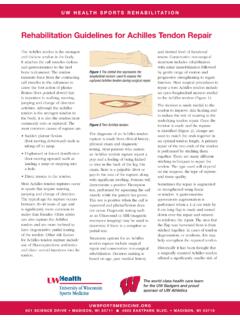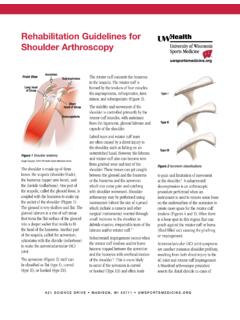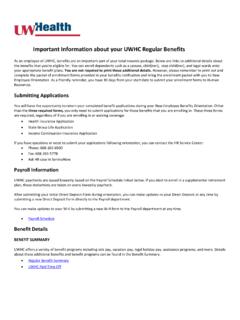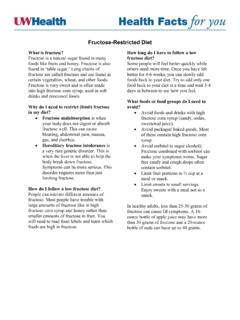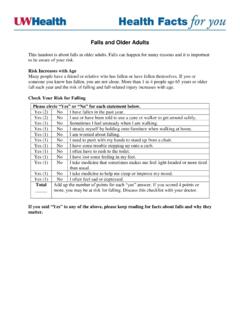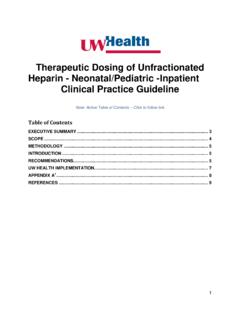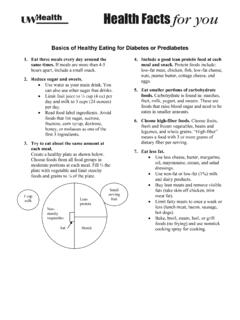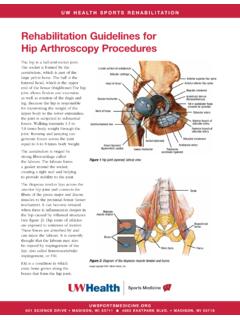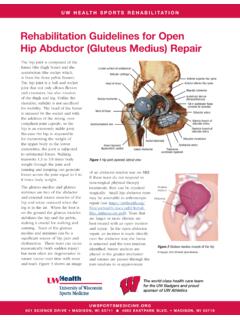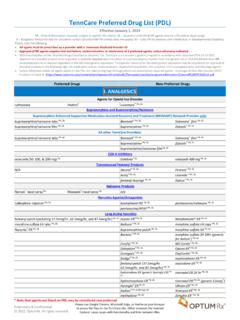Transcription of UWHC Guidelines for the Use of Linezolid (Zyvox )
1 uwhc Guidelines for the Use of Linezolid ( zyvox ) Guidelines developed by uwhc Center for Drug Policy (CDP) Authors: Deborah Dunham, MA, RPh; Sarah E. Bland, RPh Coordination: Lee Vermeulen, MS, RPh, Director, CDP Reviewed by: William Craig, MD; Barry Fox, MD; Dennis Maki, MD; George Mejicano, MD; Carol A. Spiegel, PhD Originally Approved by P&T Committee: July 2000 Last Revised: August 2009 Next Scheduled For Review: August 2011 A. Background Because of the increase in multi-drug-resistant strains of gram-positive bacteria, the development of new and novel-acting antimicrobial agents is at the forefront of pharmaceutical research. Currently, the prevalence of methicillin-resistant staphylococci (MRSA) and vancomycin-resistant enterococci (VRE) is a major clinical problem. Linezolid ( zyvox -Pfizer) is an antimicrobial agent of the oxazolidinone class that possesses a wide spectrum of activity against gram-positive organisms, including MRSA and VRE.
2 Because of Linezolid s novel mechanism of action, cross-resistance with other antimicrobial agents is not expected. Linezolid is therefore a viable option for certain types of infectious disease. B. Appropriate Indications Linezolid has limited therapeutic applications at UW Hospital and Clinics. Appropriate use of Linezolid will require a culture/susceptibility test with positive identification of an organism that demonstrates definitive resistance to all other possible antimicrobial agents. Based on the potential for bacterial resistance associated with the use of Linezolid , the UW Pharmacy and Therapeutics Committee has approved its use in the following conditions: Vancomycin-resistant Enterococcus faecium infections (not colonization), including those with concurrent bacteremia. Methicillin-resistant S aureus infections (MRSA) in patients unable to tolerate vancomycin therapy or with serious pneumonia with MRSA.
3 Combination therapy may be warranted if gram-negative organisms are present In the rare case of a patient with a gram-positive infection who is unable to tolerate other conventional antibiotics, or IV access is impossible. All orders for Linezolid require the approval of the designated Infectious Diseases physician (See section H). Step-down therapy from vancomycin IV within 24 hours of discharge in patients who will be receiving Linezolid PO as outpatients. C. Inappropriate Uses Linezolid should not be used for empiric therapy, except under unusual circumstances, or to treat mild gram-positive infections where other antimicrobial agents would be effective. D. Contraindications Linezolid is contraindicated in any person with a known hypersensitivity to Linezolid or any of the product components.
4 E. Precautions Thrombocytopenia has been reported in patients treated with Linezolid . Platelet levels in most patients returned to normal during the follow-up period. The risk of thrombocytopenia appears to be related to duration of therapy. Platelet counts should be monitored at baseline and at least every 7 days during treatment. The use of antimicrobial agents may promote the overgrowth of nonsusceptible organisms. Appropriate measures should be taken if superinfection occurs during the course of treatment. Linezolid has not been studied in patients with uncontrolled hypertension, pheochromocytoma, carcinoid syndrome, or untreated hyperthyroidism. Caution should be exercised in these patients. Lactic acidosis, peripheral neuropathy and optic neuropathy have been reported primarily with the use of prolonged courses of therapy with Linezolid .
5 Patients should be monitored for the development of these effects and prolonged courses of therapy should not be prescribed. F. Adverse Effects / Drug Interactions Linezolid has been associated with thrombocytopenia and neutropenia when given at doses up to and including 600 mg every 12 hours for 28 days. Gastrointestinal side effects associated with Linezolid include diarrhea, nausea, constipation and vomiting. Recurrent nausea and vomiting may indicate that the patient is developing lactic acidosis (see point ) Other common side effects (> 2% of patients) include headache, insomnia, rash, dizziness and fever. Less common side effects (at least 1% of patients) include oral moniliasis, vaginal moniliasis, hypertension, dyspepsia, localized abdominal pain, pruritus and tongue discoloration and lactic acidosis syndrome.
6 Linezolid is a reversible, nonselective inhibitor of human monoamine oxidase (MAO). The magnitude of this interaction has not yet been defined. Blood pressure increases of at least 30 mmHg were seen in healthy volunteers treated concomitantly with Linezolid and phenylpropanolamine or pseudoephedrine or Linezolid and foods containing more than 100 mg tyramine. Until the true extent of this interaction is known, Linezolid should be subject to the same precautions as other MAO inhibitors. Some potentially interacting substances include tyramine-rich foods, caffeine, decongestants and vasopressors. Contact Dietary for a list of tyramine-containing foods. Selective serotonin reuptake inhibitors (SSRIs) have been reported to cause serotonin syndrome when taken concurrently with Linezolid . Patients taking SSRIs should be carefully observed for the development of this syndrome if concomitant therapy is considered.
7 SSRIs may be given at a reduced dose or be discontinued for the duration of Linezolid therapy. Consult Pharmacy or authoritative literature for additional drug precautions. Linezolid has been associated with reports of peripheral neuropathy and optic neuropathy that has occasionally resulted in permanent loss of vision. Most cases of these adverse events have occurred in patients who have been treated for more than 28 days; however, some cases have occurred in patients treated for shorter periods. Lactic acidosis has been associated with the use of Linezolid . Most, but not all cases have been associated with prolonged courses of therapy beyond the recommended 28-day maximum. An alternate antibiotic should be used in cases where long-term therapy is necessary. G. Monitoring Parameters/Documentation Therapeutic Culture and susceptibility of pathogen from site of infection White blood cell count with differential Physical exam to monitor for resolution of signs/symptoms of infection Toxic Platelet and white blood cell counts should be monitored at baseline and every 7 days during treatment Blood pressure and heart rate H.
8 Infectious Disease authorization Use of Linezolid requires approval by Infectious Diseases. The physician wishing to prescribe Linezolid for an adult patient will contact pager #3333 between the hours of 0700 and 2200 to reach the ID fellow or attending ID physician on call. If ID approval is given, the ordering physician will then inform the unit pharmacist that approval has been given. A formal consult is not required, but the pharmacist or PHA should document the name of the authorizing Infectious Diseases physician in the instructions field when entering the order into Centricity. The physician wishing to prescribe Linezolid for a pediatric patient will contact the Pediatric Infectious Disease physician on call between the hours of 0700 and 2200 for approval of the order for Linezolid .
9 If ID approval is given, the ordering physician will then inform the unit pharmacist that approval has been given. A formal consult is not required, but the pharmacist or PHA should document the name of the authorizing Infectious Diseases physician in the instructions field when entering the order into Centricity. In the event of an emergency or if there is an expected delay in the approval process, such as an order written between 2200 and 0700, a single dose of drug may be dispensed by the Pharmacy without ID approval. Subsequent doses will not be dispensed until ID approval has been obtained. I. Dose and Administration Doses of Linezolid are administered every 12 hours Vancomycin-resistant Enterococcus faecium infections, including concurrent bacteremia: 600 mg IV or by mouth every 12 hours for 14 to 28 consecutive days.
10 Shorter courses of therapy ( , 10-14 days) may be suitable for other types of infections. Pneumonia or complicated skin and skin structure infections due to MRSA may be treated with 600 mg IV or by mouth every 12 hours for 8 to10 consecutive days. Linezolid injection should be administered over a period of 30 to 120 minutes. Do not use the intravenous infusion bag in series connections. Concomitant drugs should be administered separately. Intravenous Linezolid is incompatible with amphotericin B, chlorpromazine, diazepam, pentamidine, erythromycin lactobionate, phenytoin, trimethoprim-sulfamethoxazole, and ceftriaxone. The IV line should be flushed before administration of any other medications. Linezolid exhibits 100% bioavailability. Intravenous and oral Linezolid produce comparable blood levels.
